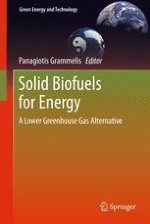
2011 | OriginalPaper | Buchkapitel
Supply of Solid Biofuels: Potential Feedstocks, Cost and Sustainability Issues in EU27
Aktivieren Sie unsere intelligente Suche, um passende Fachinhalte oder Patente zu finden.
Wählen Sie Textabschnitte aus um mit Künstlicher Intelligenz passenden Patente zu finden. powered by
Markieren Sie Textabschnitte, um KI-gestützt weitere passende Inhalte zu finden. powered by
In 2006, the total biomass contribution to primary energy consumption in the European Union was 86.6 million tons oil equivalent (Mtoe). The main share of 66.4 Mtoe was provided by solid biomass, with the remainder provided by biogas, transport biofuels and renewable solid municipal waste [1]. The bioenergy supply potential has recently been assessed at global level by (among others) the IPCC, US EPA, World Energy Council, Shell, IASA and the Stockholm Environment Institute [2, 3]. Estimates of the share of biomass in the future global energy supply range from below 100 EJ/year to above 400 EJ/year in 2050, compared to a global primary energy consumption of 420 EJ for the year 2001 [4]. One of the major reasons for the large ranges observed is that studies differed widely in their estimates of land availability and energy crop yields, and, to a lesser extent, the availability of wood and residue resources. Studies at the European level also deliver widely ranging results. Conservative results on the total biomass potential come from the EEA study [8]: how much bioenergy can Europe produce without harming the environment? It estimates a total bioenergy potential from agriculture, forestry and waste of almost 300 Mtoe in 2030. Of this, 142 MTOE will come from agriculture only which is obtained from 19 million hectares of agricultural land. This is equivalent to 12% of the utilised agricultural area in 2030. The purpose of this chapter is to provide a perspective on solid agricultural biomass feedstocks in EU27 and to summarise relevant data that influence the availability and future supply of these feedstocks for energy and fuel production. To achieve this, the chapter is structured in sections that aim to provide a series of concise answers to key questions arising regarding biomass availability and supply:
• Which types of biomass feedstocks can be produced within the available land resources of EU27 and how much of them can be estimated as available.
• What are the key cost factors and the costs ranges for residual feedstocks and energy crops.
• What are the main concerns affecting their sustainable exploitation.
• What are the main future challenges and how they can be overcome.